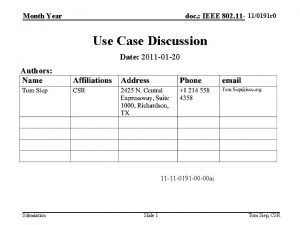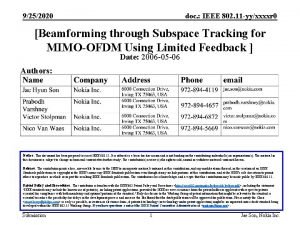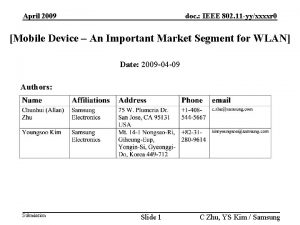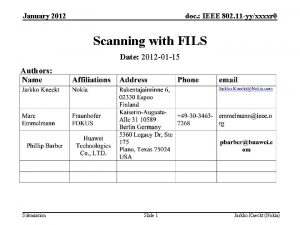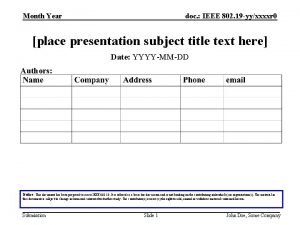110191 r 0 doc IEEE 802 11 yyxxxxr








- Slides: 8

11/0191 r 0 doc. : IEEE 802. 11 -yy/xxxxr 0 January 2011 Use Case Discussion Date: 2011 -01 -20 Authors: 11 -11 -0191 -00 -01 ai Submission Slide 1 Tom Siep, CSR

11/0191 r 0 doc. : IEEE 802. 11 -yy/xxxxr 0 January 2011 Abstract Materials to facilitate the discussions of Use Cases as a methodology to derive requirements. Submission Slide 2 Tom Siep, CSR

11/0191 r 0 doc. : IEEE 802. 11 -yy/xxxxr 0 January 2011 Basic Use Case Methodology • • Actor(s) Device sets Goal Scenario(s) Submission Slide 3 Tom Siep, CSR

11/0191 r 0 doc. : IEEE 802. 11 -yy/xxxxr 0 January 2011 Basic Use Case Methodology Actor(s) • Unique characteristics of operator, if any, of: – Initiator device – Target device operator, if any. • If more than one person, important factors: – Describe the relationship between the two people. – Level of trust – Previous history Submission Slide 4 Tom Siep, CSR

11/0191 r 0 doc. : IEEE 802. 11 -yy/xxxxr 0 January 2011 Basic Use Case Methodology Device sets • Communicating devices in the use case. • Traditional use case descriptions cite one device – Our models require that we describe the characteristics of both or all, in the case of multiple interacting devices. • Characteristics may include – – – Size power consumption hours/days between charging User Interface capability Bandwidth • Submission Slide 5 Tom Siep, CSR

11/0191 r 0 doc. : IEEE 802. 11 -yy/xxxxr 0 January 2011 Basic Use Case Methodology Goal Concise description of what the actor wants to accomplish – Time – User Inerface – device constraints Submission Slide 6 Tom Siep, CSR

January 2011 11/0191 r 0 doc. : IEEE 802. 11 -yy/xxxxr 0 Basic Use Case Methodology Scenario(s) • Text description of user interaction with in a particular situation. • There may be more than one scenario for each use case when the actor/devices/goal is the same, but the setting or other variable is significantly different. • In our particular case time to complete transaction is important Submission Slide 7 Tom Siep, CSR

11/0191 r 0 doc. : IEEE 802. 11 -yy/xxxxr 0 January 2011 Example: Home Automation and Control • Actor(s): Traveler near a Wi-Fi hotspot • Device sets: Mobile Phone Internet Access Point Home Controller Actuators; Sensor Home Controller Internet Access Point Mobile Phone • Goal: Ability to interact with home system from another device remotely and confirm action was taken • Scenario(s): – User wants to access a controller that schedules activities based on energy costs / availability. Ability to monitor the temperature and ventilation available, together with external temperature, solar inputs and wind speeds to efficiently heat / cool a building to provide an efficient use of energy. This includes automatic control of windows / blinds / shutters to control ventilation / control of solar gain. Non-time critical, several minutes response time is adequate. – Appliance determines that room is much too hot and sends alarm to remote user with current user, who determines critical situation exists and calls emergency response authorities. Time critical, sub-second notification required. Submission Slide 8 Tom Siep, CSR









